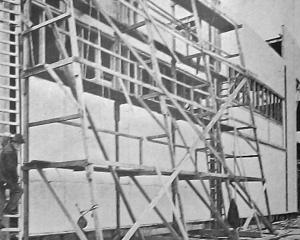There is not much that isn't talked about in today's open and "progressive" society, but there is one subject the mention of which is guaranteed to set teeth on edge, send nerves jangling and raise hackles.
The N-word, for a complex mix of sociological, historical and political reasons, has become New Zealand's last taboo, and when Central Otago artist Grahame Sydney had the temerity to raise it last week in the context of a discussion on potential alternative power sources, the reaction was predictable and swift.
Nuclear power, and indeed all things nuclear, have been off-limits - even as a matter for exploratory discussion - in this country for many years. It wasn't always so.
In the 1960s, the then Ministry of Electricity's Power Planning Committee did some preliminary and secret research into its feasibility, sending staff overseas to study nuclear power.
The possibility of nuclear generation was first introduced explicitly into the power plan in 1968 and maintained until 1977.
Various sites, including on the Firth of Thames, the Kaipara Harbour, in the Wellington region and on Banks Peninsula, were investigated.
The committee went so far as to recommend that nuclear power "must be introduced in New Zealand by about 1977", but by then slackening demand for electricity and a growing climate of opposition meant it disappeared from the plan.
In September 1976, the National government had appointed a Royal Commission to inquire into nuclear-powered generation, but by the time the commission reported back in May 1978, it concluded there was no need to consider the possibility before the next century.
It is now the "next century".
The overlapping and intervening "anti-nuclear" period is well-rehearsed and does not require detailed repetition: Labour Prime Minister Norman Kirk's sending of the frigates HMNZS Otago and HMNZS Canterbury to Mururoa Atoll in 1973 to bring world attention to French nuclear testing; a series of political manoeuvres involving the Labour government of David Lange in 1984 leading to a ban on nuclear-powered or armed United States warships, underlined by the introduction of anti-nuclear legislation three years later; the sinking of Greenpeace's protest ship Rainbow Warrior in Auckland harbour by French intelligence agents in 1985; Mr Lange's "triumphant" performance in a student debate at Oxford University.
Our nuclear-free status became sacrosanct. But should it be? And if so by what logic? It is possible, even probable, that nuclear power is not the right choice of power generation source for New Zealand.
Notwithstanding the rapidly advancing developments in technology, so that "boutique-sized" reactors are now being built with exponential advances in safety, capital costs are still very high and - even in our bigger cities - our population density is low.
However, it is time that it was included again in discussions on alternative energy sources. Energy is one of the biggest challenges facing not only this country but most of the world.
As oil supplies diminish and alternatives are considered, it does not make sense to dismiss one potential source out of what amounts to little more than prejudice and nostalgia.
Mr Sydney made his remarks during an Environment Court appeal hearing in Cromwell last Tuesday for the proposed $1.5 billion Project Hayes wind farm on 92sq km of the Lammermoor Range.
"If given the option between 176 turbines on the sweeping Central Otago vistas and a single nuclear station, I would certainly prefer the latter," he said during cross-examination.
When contacted after the hearing, he clarified his remarks.
"It was in the context of being given an option between a small-scale single nuclear power station near Auckland, or being given Project Hayes," he said, adding that nuclear power was in fact very low on his list of options for New Zealand's energy sources.
Part of Mr Sydney's point, of course, was that perhaps when the debate is being conducted about future energy sources, rather more weight should be given to proximity of generation facilities to the major markets, in this case the top half of the North Island.
There seems to be a default position on the part of energy planners that the South Island offers endless bounty and is simply waiting to be despoiled in the pursuit of it, regardless of the infrastructural costs associated with conveying the captured energy to its end-users.
This is most decidedly not the position of a large numbers of residents in the region, and visitors to it, for whom the beauty of its lakes, rivers and mountain ranges is unsurpassed.
With his submission against the visual pollution entailed by the erection of 176 giant turbines on the Lammermoors, Mr Sydney gives the argument further and fresh impetus.
The South needs to put a high value on its natural beauty. Many, rightly, regard it as priceless.












